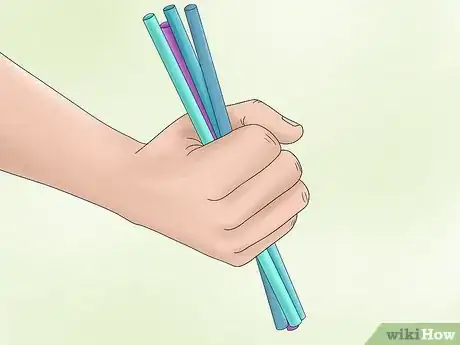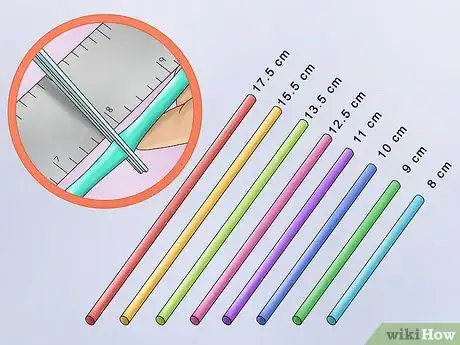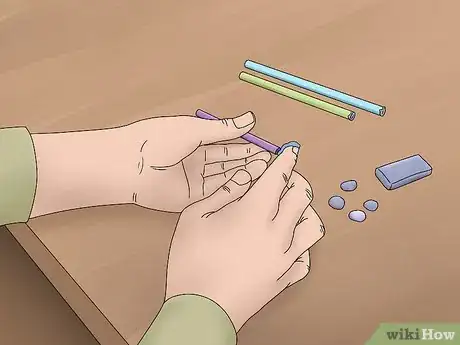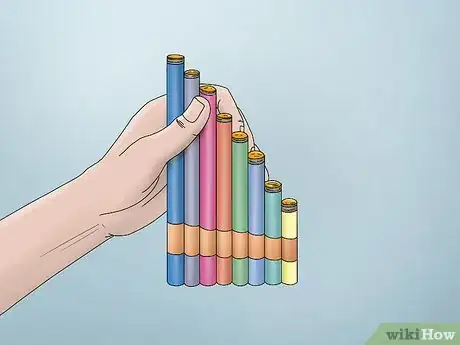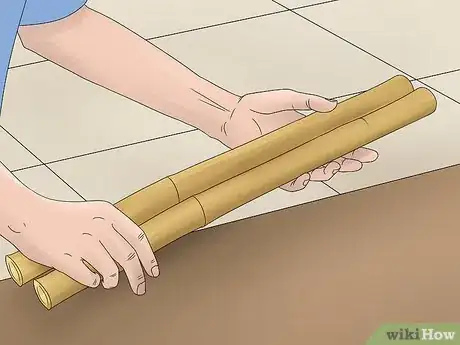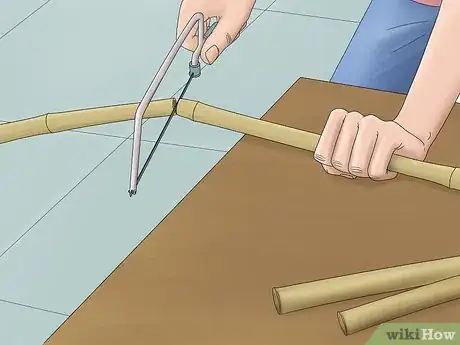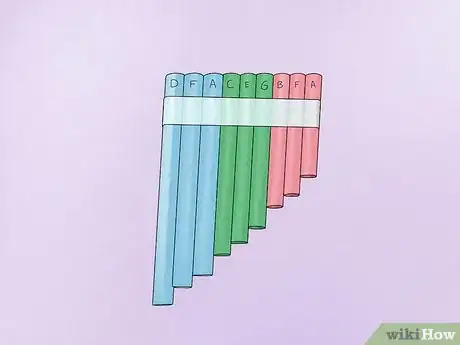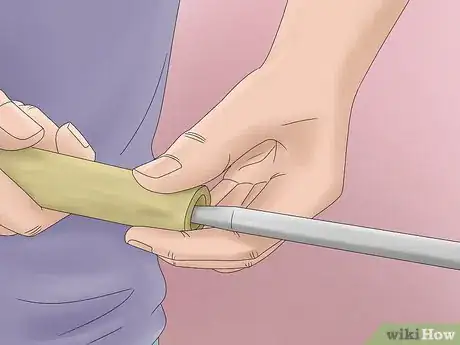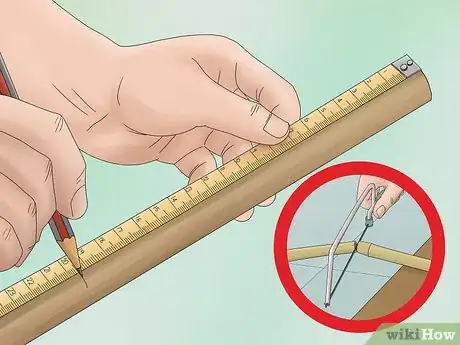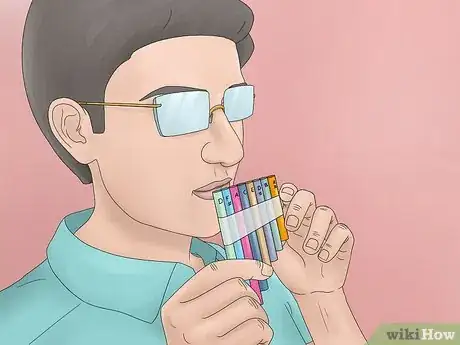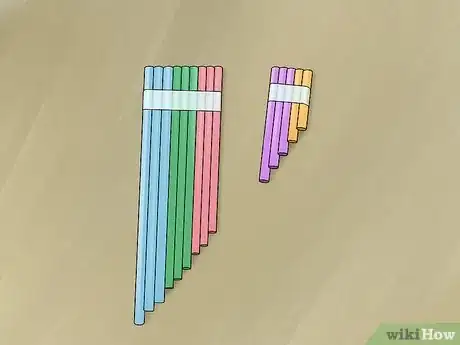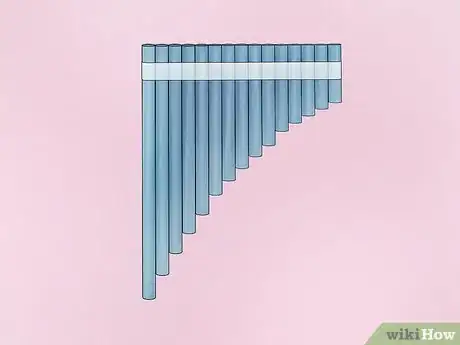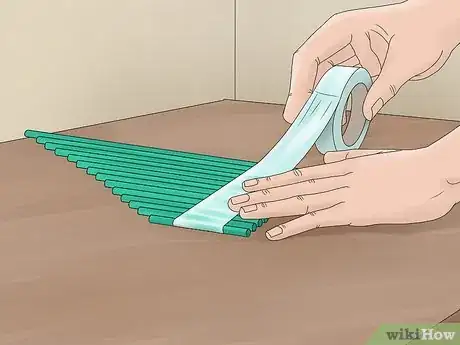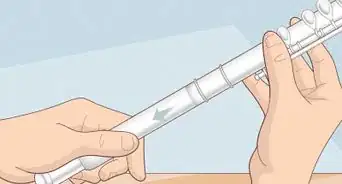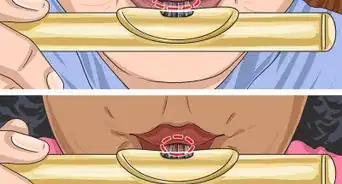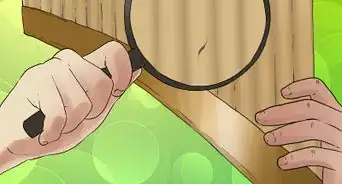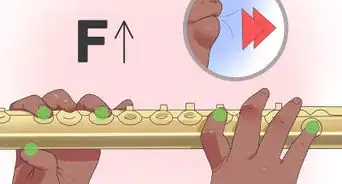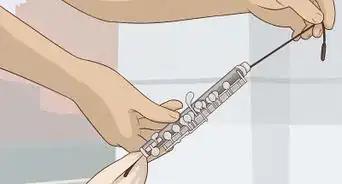This article was co-authored by wikiHow Staff. Our trained team of editors and researchers validate articles for accuracy and comprehensiveness. wikiHow's Content Management Team carefully monitors the work from our editorial staff to ensure that each article is backed by trusted research and meets our high quality standards.
There are 7 references cited in this article, which can be found at the bottom of the page.
This article has been viewed 230,439 times.
Learn more...
Pan pipes are wind instruments that produce a soft, melodious sound. Pan pipes get their name because they are made up of a series of pipes that you blow across to produce sound. Many people don't realize that pan pipes are one of the few musical instruments you can easily make at home. The process of constructing the pan pipes is fairly easy, but you will want to make sure to measure and cut the pipes carefully to be able to achieve the sound you want.
Steps
Creating Straw or PVC Pipes
-
1Buy your supplies. Straws and PVC pipe are two different materials you can use to make pan pipes. Straws are the easiest materials to use to make pan pipes. However, their sound quality is not as good as PVC pipes. PVC pipes give you better sound quality, but they are less easy to cut than straws. Take this into consideration when you are choosing the right material for your project.
- If you are using straws to create your pipes, buy fat straws meant for smoothies or bubble tea. You can find these at stores like Walmart or at your grocery store. Make sure not to get normal or restaurant-style straws. These are not as effective as thicker straws and are much harder to play.
- If you are using PVC pipe, buy a ½ inch PVC schedule 40 pipe at stores like Home Depot or Walmart.[1]
-
2Cut the pipes. Use scissors to cut straw pipes, and a rotary conduit cutter or hack saw to cut PVC pipe. It can be difficult to say exactly what notes the pipes will create when you cut them to certain lengths, because the pitch also depends on the width of the straws or PVC pipe, which can vary across brands. However, you can get a well-tuned set of pipes in a diatonic scale by cutting your pipes to the following lengths:[2]
- Pipe 1: 17.5 cm
- Pipe 2: 15.5 cm
- Pipe 3: 13.5 cm
- Pipe 4: 12.5 cm
- Pipe 5: 11 cm
- Pipe 6: 10 cm
- Pipe 7: 9 cm
- Pipe 8: 8.5 cm
- You can also blow across your pipes and see if they produce the sound you want. You can cut your pipes shorter if you want a different sound.
- For this reason, it's always a good idea to cut your pipes slightly longer than needed, because you can always adjust them to make them shorter.
Advertisement -
3Make a clay plug. In order to produce sound, you will need to plug the bottom of the pipes. Take modeling clay and make it into a flat circle. Then take a straw or PVC pipe and stamp into the clay with an end. Twist the pipe or straw, then lift it up. This should leave a circle exactly the size of the opening. Take out this piece of clay.[3]
-
4Plug the bottom of the pipe. Take the clay plug you made and push it into one of the pipes you have cut for your pan pipes. This will plug the bottom. To make sure it stays, take some tape and wrap it around the bottom of the pipe to secure it. Do this process for the remaining pipes.[4]
Turning Bamboo into Pipes
-
1Pick out or buy bamboo stalks. If you are making your pipes out of bamboo, buy as many stalks as you need. If you live in a warm climate that grows bamboo, you may be able to find bamboo outside or at local shops. If you don't have access to bamboo in your community, order it online. Make sure each stalk of bamboo has around a 5/8 inch diameter.[5]
- It's important that all the stalks have a similar interior diameter, or else it will be hard to make them sound good together.
- Make sure the bamboo isn't green, and instead is dried and tan in color.
-
2Cut the bamboo in front of its first node. Take a stalk of bamboo and cut it at one end right before the first node using a saw. The nodes of the bamboo are the lines that run horizontally across the stalk that you can see from the outside. The nodes are closed on the inside, so they create a good natural bottom to your pipes.[6]
-
3Sand the node area. After you have made the cut before the node, use a belt sander to make the outside bottom of the bamboo stalk rounded. This isn't necessary, but it will make the bottoms of your pipes less prickly and spiky, and will also make your instrument look better. Do the same process for all of your bamboo pieces.
-
4Measure out your pipes. Use the same measurements for the straw pan pipes, starting with the longest pipe at 17.5 cm and the shortest at 8.5 centimeters. Use a ruler to measure and mark these measurements on the bamboo.
-
5Clean out nodes between sections. After forming the bottom of the pipes around the node, you will want to clear the inside of the bamboo, still keeping the bottom node untouched. Since nodes are closed on the inside, they will stop air from going through the entire pipe and will interfere with your sound.[7]
- Use a steel rod with roughly a 3/8 inch diameter to break through the nodes inside of the bamboo shaft.
- An effective way to do this is to clamp down the steel rod, and then take the bamboo shaft and poke the nodes out using the rod.
- You also will want to use the rod to scrape around the inside of the bamboo nodes so that the inside node area has the same interior diameter as the rest of the stalk.
-
6Cut the bamboo according to the measurements. Using the measurements you already marked down, cut the bamboo into differently-sized pipes. Remember that it's better to cut your pipes a little too long than too short, because you can always do another cut.[8]
Finishing the Pan Pipes
-
1Test the sound. Before you put your pipes together, first make sure that the pipes give you the notes you want. You should have a diatonic scale by using the measurements provided, but you should still check it to make sure it sounds right. If you want your pan pipes set in a specific key, for instance, the key of G, use a piano or music tuner to find the lengths that you want.
- For example, if you want your pan pipes in the key of G, play a G on a piano, tuner or another instrument.
- Cover the bottom hole of the pipe with your thumb so it's completely covered. Then place your bottom lip on the rim of the pipe, purse your lips and blow across the pipe.
- If the note does not match the G, cut off a tiny bit of pipe and try again.
- Keep doing this until you match the G. Then do the same on another pipe to make an A, etc. until you have all your desired notes.
-
2Adjust the number of pipes as you wish. You can add more pipes if you want, or take off some pipes. There aren't a set number of pipes used in pan pipes. Many pan pipes have either 5 or 8 pipes, but the number of pipes in your instrument is completely up to you. Romanian pan pipes even have twenty pipes!
-
3Lay the pipes out. When you are ready to attach the pipes together, lay them out longest to shortest. Make sure that all the plugged ends of the pipes are all on the same side. Line the pipes up so that the top ends of the pipes are all in line with each other, and the plugged ends are staggered in a diagonal.[9]
-
4Reinforce the pipes. You need to attach the pipes to each other so they can stay together as a unit.[10]
- For straw pan pipes, simply wrap tape around all of the pipes several times. To keep the pipes straight, place a chopstick or popsicle stick across the middle of the pipes, and super glue it down.[11]
- For PVC or bamboo pipes, you will need to use a stronger material to reinforce the pipes. Use duct tape and a lightweight wooden rod to reinforce the pipes. You can also use twine for a more attractive finished product. Criss-cross the twine across each pipe and the piece of wood to bind the wooden rod to the pipes.[12]
- Super glue around the reinforcements for extra support.
-
5Sand the pipes. If your pan pipes are made of straw, you do not have to sand them. However, PVC pipe and bamboo can be jagged when cut. If you notice that the top ends of the pan pipes are sharp, use sandpaper to smooth them out. The last thing you want is to get splinters when you're playing your new instrument![13]
- If you are making bamboo pipes, also sand the bottom of each pipe where you made the cut at the node.
Community Q&A
-
QuestionIs there a blockage needed on the ends of the pipes to improve the sound?
 Community AnswerYes, without the closed off bottom you can't produce musical notes. Without a bottom you would just get a whistling sound.
Community AnswerYes, without the closed off bottom you can't produce musical notes. Without a bottom you would just get a whistling sound. -
QuestionDoes the type of tape affect the sound?
 Community AnswerNo, the tape is on the outside. You can also add stickers and it won't affect it unless it's too heavy.
Community AnswerNo, the tape is on the outside. You can also add stickers and it won't affect it unless it's too heavy. -
QuestionIs there a way to space them out more?
 Community AnswerYes, you can space out the pipes by adding popsicle sticks or wooden rods between each pipe. Put as many as you see fit to give you the spacing you want.
Community AnswerYes, you can space out the pipes by adding popsicle sticks or wooden rods between each pipe. Put as many as you see fit to give you the spacing you want.
Warnings
- Always be extremely careful when using sharp or heavy equipment like saws.⧼thumbs_response⧽
References
- ↑ http://www.panflutejedi.com/tube-lengths.html
- ↑ http://mykidcraft.com/straw-pan-pipes/
- ↑ http://www.wildmusic.org/files/panpipes.pdf
- ↑ http://www.philtulga.com/Panpipes.html
- ↑ http://www.panflutejedi.com/jean-paul-tutorial.html
- ↑ http://www.panflutejedi.com/jean-paul-tutorial.html
- ↑ http://www.panflutejedi.com/jean-paul-tutorial.html
- ↑ http://mykidcraft.com/straw-pan-pipes/
- ↑ http://www.wildmusic.org/files/panpipes.pdf
About This Article
If you want to make your own panpipes, gather 8 large straws, like the kind used for smoothies, and cut each one in descending length from 17.5 cm to 8.5 cm. Plug the bottom of each straw with a small circle of modeling clay. Arrange the straws in order from longest to shortest, lining them up so that the unplugged ends are all level with each other, then carefully wrap a piece of tape around the middle of the straws to hold them all in place. Hold the pipe to your lips so the plugged ends of the straws are pointing down to your feet, then blow across the openings of the straws to play notes. For tips on making your panpipes from PVC or bamboo, keep reading!
